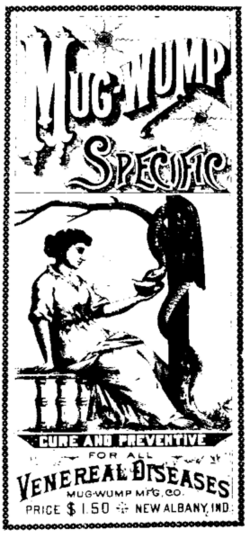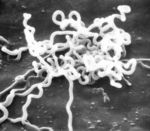Venereal disease: Difference between revisions
imported>Nancy Sculerati No edit summary |
imported>Nancy Sculerati No edit summary |
||
| Line 1: | Line 1: | ||
[[Image:278px-Mugwump Specific.png|thumb|left|250 px|Before the antibiotic era, infections with syphilis and gonorrhea were common, but effective treatments were rare. The medications that actually had an affect on the disease were also toxic to the patient, heavy metal compounds being the best of them. Patent medicines were widely available in the USA in the 19th century- whether they worked or not.]] | [[Image:278px-Mugwump Specific.png|thumb|left|250 px|Before the antibiotic era, infections with syphilis and gonorrhea were common, but effective treatments were rare. The medications that actually had an affect on the disease were also toxic to the patient, heavy metal compounds being the best of them. Patent medicines were widely available in the USA in the 19th century- whether they worked or not.]] | ||
'Venereal diseases' are infections spread through sexual contact. When the term was coined, in the 19th century, sexual activity was the only common "intimate" means of sharing body fluids. Since that time, with the advent of blood transfusion, organ transplant, and groups of substance abusers who share hypodermic equipment for injecting drugs, some of the same fastidious organisms that could only survive transmission from an infected person to a new host through body fluids shared in sexual contact, are now also able to survive through these other forms of transport. | 'Venereal diseases' are infections spread through sexual contact. When the term was coined, in the 19th century, sexual activity was the only common "intimate" means of sharing body fluids. Since that time, with the advent of blood transfusion, organ transplant, and groups of substance abusers who share hypodermic equipment for injecting drugs, some of the same fastidious organisms that could only survive transmission from an infected person to a new host through body fluids shared in sexual contact, are now also able to survive through these other forms of transport. | ||
Some venereal diseases can be passed from an infected mother to her baby: either during pregnancy, birth, or through breastfeeding. This fact has changed the utility of breastfeeding in some areas, like subSaharan Africa, where the rate of HIV, which is transmitted in breast milk is very high. | |||
[[Sexually Transmitted Disease]] (STD) include ''both'' the venereal diseases and other infections. These other infections can be spread in ''many'' ways, but are so likely to be transmitted by sexual contact with an infected person that they are included in the category of sexually transmitted disease. | [[Sexually Transmitted Disease]] (STD) include ''both'' the venereal diseases and other infections. These other infections can be spread in ''many'' ways, but are so likely to be transmitted by sexual contact with an infected person that they are included in the category of sexually transmitted disease. | ||
Revision as of 14:09, 5 May 2007

'Venereal diseases' are infections spread through sexual contact. When the term was coined, in the 19th century, sexual activity was the only common "intimate" means of sharing body fluids. Since that time, with the advent of blood transfusion, organ transplant, and groups of substance abusers who share hypodermic equipment for injecting drugs, some of the same fastidious organisms that could only survive transmission from an infected person to a new host through body fluids shared in sexual contact, are now also able to survive through these other forms of transport.
Some venereal diseases can be passed from an infected mother to her baby: either during pregnancy, birth, or through breastfeeding. This fact has changed the utility of breastfeeding in some areas, like subSaharan Africa, where the rate of HIV, which is transmitted in breast milk is very high.
Sexually Transmitted Disease (STD) include both the venereal diseases and other infections. These other infections can be spread in many ways, but are so likely to be transmitted by sexual contact with an infected person that they are included in the category of sexually transmitted disease.
